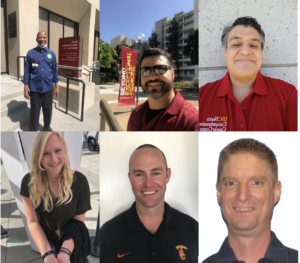By late March, the USC Health Sciences Campus had emptied out as students, staff and faculty sheltered at home to prevent the spread of COVID-19. However, it was simply not possible to halt all research, construction, and case-by-case campus access needs.
Since the start of quarantine, the Keck School of Medicine’s Facilities and Space Planning teams have been diligently showing up every day to keep essential activities up and running, and to prepare campus for our eventual return.
They are hard at work, with their boots on the now-desolate ground, granting access to essential employees, installing sanitation stations and collecting and delivering personal protective equipment (PPE) donations. All throughout, their dedication to the KSOM community in light of the crisis has remained steadfast and nothing short of admirable.
Sri Sankarapu, Director of Space Planning at the Keck School of Medicine, manages the facilities and space planning team responsible for overseeing 19 buildings on the Health Sciences Campus that have a Keck School of Medicine presence. One might assume her team’s workload has decreased due to the shutdown, but it’s quite the opposite––she said they’re working harder than ever as front-line responders to handle any facilities and logistics needs that arise. Sankarapu said the work has been manageable thanks to her team members taking the initiative and adapting to situations swiftly and cooperatively.

The facilities and space planning team, clockwise from top left: Wayne Tulloss, Jose Cea, Alfred Ascencio, Rusty King, Ryan Maier and Heather Pupecki.
When the shutdown first began, her team was responsible for winding down all business and research activity across campus, while still allowing access for essential personnel. The facilities coordinators were entrusted with monitoring 11 research buildings and allowing essential access to ensure the preservation of years’ and millions of dollars’ worth of frozen research samples. When a city power outage hit numerous research buildings on a Friday evening, the facilities coordinators showed up in full force by Saturday morning and spent the entire day authorizing access for essential researchers to check on their samples.
Sankarapu’s team has been tasked with implementing building access privileges for all essential KSOM personnel, and she credits facilities coordinator Jose Cea for his diligence in processing badge access requests for essential employees and remaining on call to troubleshoot issues that arise. The Facilities and Space Planning teams also must prepare on-campus sites for summer construction. When students were asked to stay home, they left behind personal items in classrooms slated for renovation, so space planning assistant Heather Pupecki took responsibility for clearing away personal belongings and storing them safely in anticipation of the students’ return.
Although the team members are all essential employees, they created a rotation system to split their duties, ensure social distancing and allow each team member some stay-at-home days. Still, Sankarapu said everyone has been quick to offer support and show up to assist without hesitation in case of emergencies. She highlighted team members Wayne Tulloss , Rusty King, Ryan Maier, and Alfred Ascencio, as well as KSOM Emergency Preparedness Administrator William Myles, for stepping up and making the campus-wide ramp-down as seamless as possible.
“I have a very proactive team, and I’m really, really thankful for them,” Sankarapu says, noting that even in times of crisis, the Trojan Family finds ways to support each other and surmount challenges by working together.
— By Alexandra Demetriou
